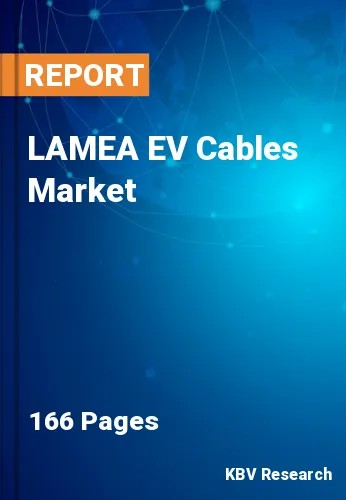The Latin America, Middle East and Africa EV Cables Market would witness market growth of 17.7% CAGR during the forecast period (2023-2030).
Toxic compounds in vehicle exhaust emissions, including carbon monoxide, sulfur dioxide, nitrogen oxides, and others, contribute to global warming, health issues, and others. Exhaust emissions are kept to a bare minimum in electric vehicles. Excessive reliance on fossil fuels, such as coal and petroleum, and other energy sources leads to the depletion and extinction of natural resources.
The demand for commercial and industrial EVs, from freight trucks to aviation ground support vehicles, is growing concurrently with that of the consumer sector. The construction of secure, effective, and practical charging outlets is a top priority for the industrial sector. Manufacturers have been enhancing EV charging stations for as long as electric vehicles have been a mainstay of factories and warehouses. The performance, effectiveness, and safety of electric cars are all enhanced by the usage of these cutting-edge technologies.
Although EV adoption is still in its infancy in Latin America, the Middle East, and Africa, these regions are increasingly seeing an increase. The regional nations are making investments in EV adoption policies and charging infrastructure development, which will increase demand for EV charging cables in the future. In the Middle East, nations like Saudi Arabia and the United Arab Emirates are leading the way in the adoption of electric vehicles. Plans call for the Saudi Arabian Standards Organization (SASO) to publish rules governing the usage of electric vehicles. The Colombian government also unveiled incentives for clean-energy automobiles at the same time. The regional market is expanding as a result of these factors.
The Brazil market dominated the LAMEA EV Cables Market by Country in 2022, and would continue to be a dominant market till 2030; thereby, achieving a market value of $452.5 million by 2030. The Argentina market is estimated to witness a CAGR of 18.3% during (2023 - 2030). Additionally, The UAE market would showcase a CAGR of 17% during (2023 - 2030).
Based on Shielding Type, the market is segmented into Copper, Aluminium, and Others. Based on Application, the market is segmented into Charging Management, Engine & Powertrain, Battery & Battery Management, Power Electronics, and Others. Based on Voltage, the market is segmented into High, Medium, Low, and Very High. Based on Component, the market is segmented into Wires, Connectors/Terminals, and Fuse & Others. Based on EV Type, the market is segmented into BEV, HEV, and PHEV & Others. Based on Insulation Material, the market is segmented into Thermoplastic Elastomer, Silicon Rubber Insulation, Fluoro Polymers, and Others. Based on countries, the market is segmented into Brazil, Argentina, UAE, Saudi Arabia, South Africa, Nigeria, and Rest of LAMEA.
Free Valuable Insights: The Worldwide EV Cables Market is Projected to reach USD 23.1 Billion by 2030, at a CAGR of 15.7%
The market research report covers the analysis of key stake holders of the market. Key companies profiled in the report include HUBER+SUHNER AG, TE Connectivity Ltd., Leoni AG, Aptiv PLC, Nexans S.A., Sumitomo Electric Industries, Ltd., Elkem ASA (Bluestar Elkem International Co., Ltd. S.A.), Sinbon Electronics Co., Ltd., Coroplast Fritz Müller GmbH & Co. KG, and Philatron Wire & Cable
By Shielding Type
By Application
By Voltage
By Component
By EV Type
By Insulation Material
By Country
Our team of dedicated experts can provide you with attractive expansion opportunities for your business.

